North American railway glossary
By
Wikipedia,
the free encyclopedia,
http://en.wikipedia.org/wiki/List_of_U.S._railfan_jargon
Become a member of TranslationDirectory.com at just
$12 per month (paid per year)
Advertisements:
Use the search bar to look for terms in all glossaries, dictionaries, articles and other resources simultaneously
This page contains a list of terms, jargon, and slang used to varying degrees by railroad enthusiasts / railfans and railroad employees in the United States and Canada. Although not exhaustive, many of the entries in this list appear from time to time in specialist, rail-related publications. Inclusion of a term in this list does not necessarily imply its universal adoption by all railfans and railroad employees, and there may be significant regional variation in usage.
This list does not include nicknames for railroad companies; those can be found
at Railroad
nicknames.
A
- ALCOhaulic: Nickname for the DH643 diesel-hydraulic locomotive built by American Locomotive Company (ALCO).[1] Also a nickname for railfans who are "addicted" to ALCO locomotives.
- Amcan: An Amfleet passenger car; the car shape is a rounded stainless steel tube.[5][6]
- Amshack: A small shelter that serves as a train station for Amtrak trains in a small town. There are normally no manned services offered at these small stations.[7]
B
- B-Boat: GE B23-7, B30-7 or B36-7 locomotive. By analogy with U-boat, since with the Dash 7 line, the "B" or "C" moved to the beginning of the designation.[8]
- Bandit: Nickname for Milwaukee Road engines after the railroad was sold to the Soo Line Railroad. The Soo covered up the Milwaukee Road name and logo on the orange locomotives with black paint, causing them to resemble bandits.[12][13][14]
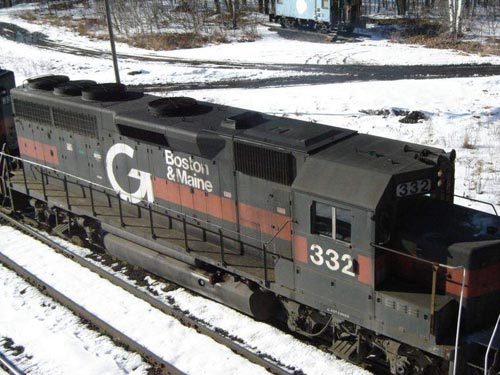
- Billboard: Santa Fe locomotive in the pre-1972 blue and yellow scheme.[4]
- Bloody Nose: Southern Pacific locomotive (post-1959 grey and red paint scheme where the nose of the diesel locomotive was painted in scarlet red).[4][8][14]
- Bluebonnet: one of two Santa Fe paint schemes. The standard freight scheme from 1972 until the BNSF merger was dark blue with yellow on the front, with the same color division as the warbonnet scheme. It is also known as Yellowbonnet. Bluebonnet can also mean a warbonnet unit with only the red painted over, resulting in a silver and blue locomotive; this was used on passenger engines transferred to freight service after the formation of Amtrak.[4]
- Bright Future: The middle CSX tricolor paint scheme (also known as Yellow Nose 2 or YN2).[28][29]
- Bull: a railroad police officer.[4][19]
C
- Cabbage: Former F40PH locos with the diesel engine removed, and a roll-up baggage door installed in the center of the carbody; used as cab/baggage cars in Amtrak push-pull service.[31]
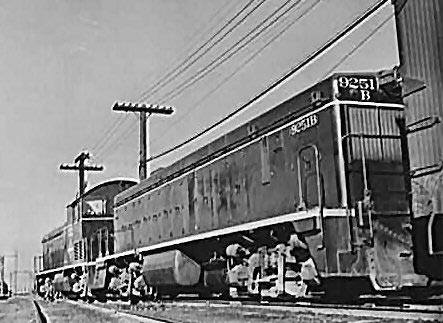
- Can Opener: Conrail's herald.[34]
- Centennials: Name given to Union Pacific's EMD DDA40X locomotives. World's most powerful diesel locomotives, delivered in 1969, the year of Union Pacific's centennial.[36]
- Ches-C: Chessie System's kitten logo; the profile of the Chesapeake and Ohio's sleeping kitten mascot "Chessie" appears inside the corporate C logo.[37][38]
- Circus loading: Loading trailers on flatcars sequentially from the end; the standard method of loading in early piggyback service.[39]
- Coffin car: Nickname for a passenger car with an engineer's cab. Also known as a cab car or control car. [44]
- CPLs: Color Position Lights, PRR style signal heads with new color lenses installed.[46]
- Critter: A small industrial locomotive.[47][48]
D
- Dark Future: The current CSX paint scheme, also known as Yellow Nose 3 (YN3) or Gold Nose 1 (GN1).[14][35]
- Darth Vader: Term used to describe the lens hood on a modern style of railroad signals, due to its visual resemblance to the helmet of Darth Vader from Star Wars.[50]
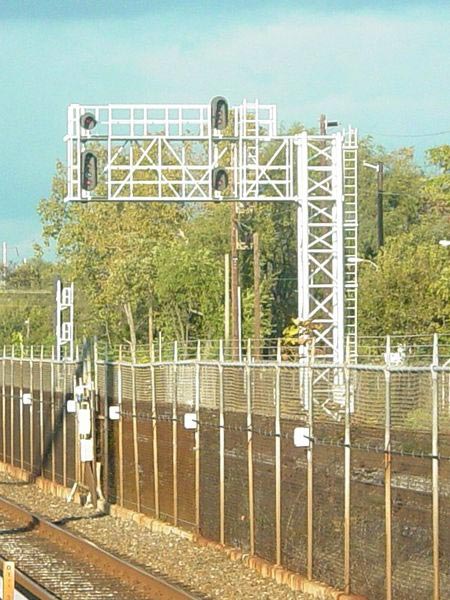
- Draper-Taper: Nickname for certain Canadian locomotives that feature a full-width carbody with improved rear visibility, designed by William L. Draper, an employee of Canadian National Railway. [53]
E
- Elephant-style: A lashup of multiple locomotives with all units facing forward; resembling the nose-to-tail train of elephants in a circus parade.[56]
F
- Fallen flag: a railroad company that no longer operates, or has been merged with (or acquired by) another railroad company.[57][58]
- Flares: Refers to the EMD SD45, with its dynamic brake blisters and radiators that distinctively flare from the top of the unit. Also Flare 45. Both forms distinguish the SD45 from the SD45-2 and SD45T-2, which lack flared radiators. [59]
- Wings/Flags/Flares (W/F/F): Characteristics used to designate Union Pacific's paint scheme and engine type. Wings = "Wing" Decal on the engine nose, Flags = "American Flag" Decal on engine body, Flares = "Flared Radiators" of certain SD70Ms on the long hood. Some UP engines have one or more of these characteristics.[14][35]
- Flatback: Industry slang for trailer-on-flatcar service in the 1970s, especially in the trade journal Railway Age.[60]
- Foamer: a railfan, particularly one whose enthusiasm appears excessive.[61]
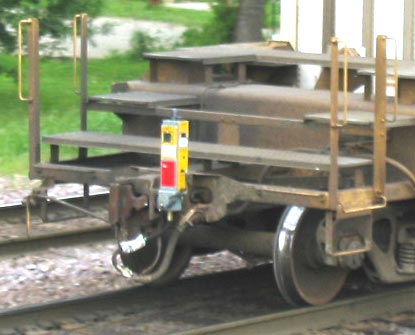
- FRN: an acronym for "fucking rail nut", a derogatory term used by some railroaders to describe railfans.[64]
G
- Geep: Nickname for EMD's GP series of locomotives.[8][66]
- Genset: A locomotive that uses multiple high-speed diesel engines and generators (generator sets), rather than a single medium-speed diesel engine and a single generator. Sometimes confused with Green Goat locomotives; the only similarities between the two types are their outward appearance and that both are designed to reduce air pollution and fuel consumption.[68]
- GN1: Gold Nose 1, the current CSX paint scheme. Another term for YN3.[70]
- Green Goat: A type of "hybrid" switching locomotive utilizing a small diesel engine and a large bank of rechargeable batteries.[71]
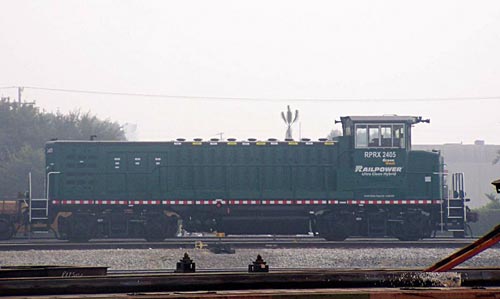
H
- Hammerhead: A GE locomotive with "winged" radiators, when running long hood forward.[72]
- High Ball: Another term for a clear signal, derived from the days of steam where a station operator would hoist a ball up the scaffold, signalling the engineer he was authorized to proceed.[19][42][73][74][75]
- Hot box: Overheated wheel bearing. This comes from the era before the widespread use of roller bearings where friction bearings (copper jackets) wrapped around the axle of the car and were housed in a journal box filled with oil. An overheated axle led to a hot journal box.[75][79][80]
I
J
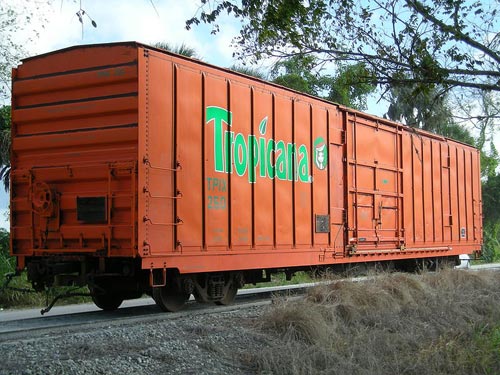
K
- Kodachrome: Southern Pacific Santa Fe Railroad's red, yellow and black paint scheme, which resembled the packaging of Kodachrome color transparency film. This was the scheme instituted when the merger between Southern Pacific and Santa Fe was assumed to be approved. Hundreds of locomotives were painted in Kodachrome colors before the merger was denied.[8][29]
L
M
- Manifest: A freight train with a mixture of car types and cargoes.[84][85]
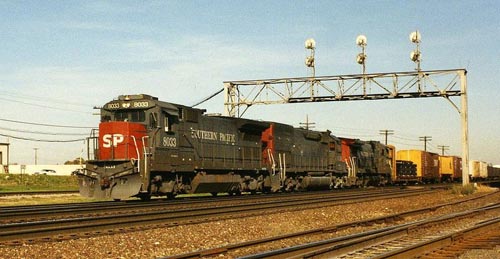
- Meatball/Swedish Meatball: Amtrak EMD AEM-7 / ABB ALP-44 electric locomotives; so named for their design being based on the Swedish Rc4.[86]
- Miniquad: Four ore cars (jennies) permanently coupled.[87][88]
- Minuteman: The name given to the tuscan red and gold paint scheme applied to Boston & Maine diesel-electric locomotives from the 1950-early-1960s era. The road's herald bearing the famous Revolutionary-inspired Minute Man statue.
- Mother: The locomotive that is paired with a slug.[27]
P
- Patch: (also patch job) A locomotive wearing a new reporting mark and/or number on a "patch" over existing paint, usually of the former owner's.[14][90]
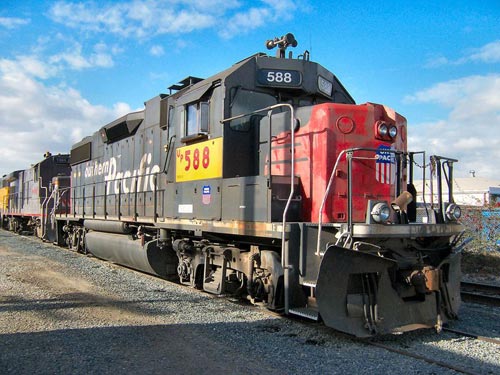
- Pepsi Can: An Amtrak GE Dash 8-32BWH, in reference to the units' original paint scheme with large red and blue stripes.[8]
- Pig train: a train devoted exclusively to intermodal (piggyback) traffic, generally trailers on flatcars (TOFC) or containers on flatcars (COFC).[93]
- Private varnish/PV: privately owned passenger cars.[94][95]
R
- Racetrack: Nickname for a stretch of Metra Commuter Rail line and BNSF freight line between Chicago and Aurora, Illinois where commuter trains and freight trains commonly attain high speeds[99]. Also used to refer to the parallel tracks of the O&W and DL&W north of Norwich[100].
- Raccoon: Norfolk Southern locomotives that have the entire area around the cab windows painted white, resembling the face of a raccoon.[14]
- Rare Mileage: A passenger train traveling over track that does not have regular passenger service.[101]
- Rent-a-Wreck: Locomotive owned by a leasing company.[102]
- Roster Shooter: Someone interested in photographing every locomotive road number they can.[103]
S
- Screamer or Screaming thunderbox: EMD F40PH locomotive, in reference to it operating in a constant state of full throttle (in order to provide head-end power to passenger cars).[35] Coined by MBTA railfans.
- Sergeant Stripes: a Canadian National locomotive in the 1970s-1980s paint scheme featuring light grey stripes on the locomotive's long hood.[14][104]

- Slug: A locomotive, with or without an operator's cab, which lacks a diesel engine, and draws power for its traction motors from a normal locomotive, known as a "mate" or "mother."[20][27][22]
- Speeder: a small, motorized track inspection vehicle. Also called motorcar, trackcar, putt-putt, or golf cart.[105]
- Stacks: Nickname for double-stack cars or trains.[106]
- Stealth Unit: The early CSX grey & blue paint scheme. So named for their virtual invisibility in poor light. Also used to describe NS D9-40CWs in light gray primer paint, and a scheme used on some Metro-North locomotives.[8][29]
T
- Toaster: Amtrak AEM-7/ALP-44 or GE P42DC locomotives. Also used to refer to any GE locomotive, due both to their tendency to shoot flames out of the exhaust stack during Turbo Lag and to General Electric's historic involvement in the manufacture of household appliances.[8][35]
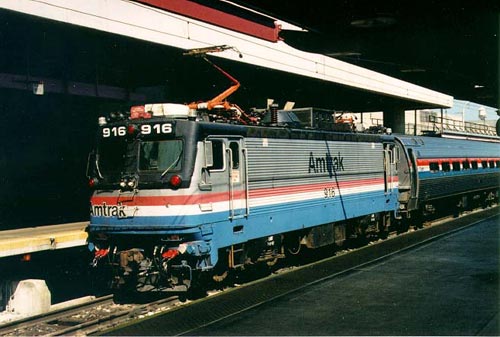
- Tunnel Motor: Southern Pacific EMD SD40T-2 / EMD SD45T-2. Named for the lower-located air intakes to prevent the locomotive from pulling diesel exhaust in with the clean air while traveling through a tunnel.[109][110]
- Turbo Lag: Characteristic of Alco and GE diesel locomotives, where the turbocharger lags behind the throttle-up of the engine, shooting dense clouds of black smoke and/or flames from the exhaust stack when initially throttling up.[111]
U
V
- Vomit Bonnet: BNSF's first attempt at a paint scheme. [113]
W
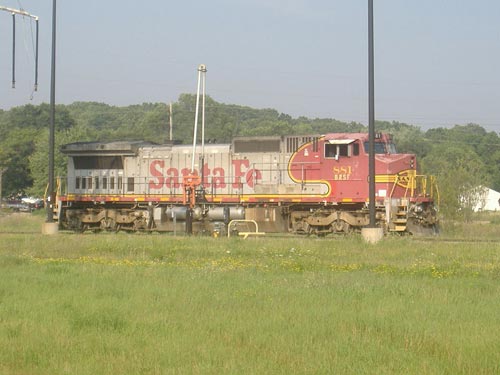
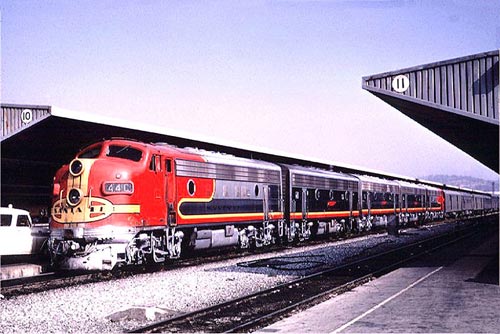
- Warpumpkin: Name given to the BNSF orange and black update of the classic Sante Fe Warbonnet scheme.[8]
- Washboards: name given to M.U. cars, subway cars, and other equipment made with corrugated side panels that resembled washboards.[114]
Y
- Yellowbonnet: one of two Santa Fe paint schemes. The standard freight scheme from 1972 until the BNSF merger was dark blue with yellow on the front, with the same color division as the warbonnet scheme. It is also known as Bluebonnet. Yellowbonnet can also mean a warbonnet unit with only the red painted over, resulting in a silver and yellow locomotive; this was used on passenger engines transferred to freight service after the formation of Amtrak.[14][29][117]
- YN1: CSX's first yellow-nose paint scheme; gray overall with dark blue on the top half of the cab and yellow on the front of the nose; blue "CSX" lettering.[14][29]
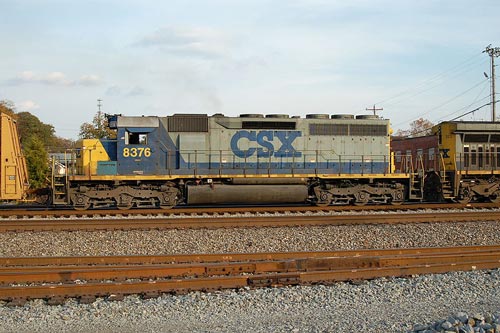
- YN2: CSX's second yellow-nose paint scheme; more yellow on the nose; the whole cab is dark blue, along with a stripe on the side; blue or yellow "CSX" lettering.[14]
- YN3: CSX's third yellow-nose paint scheme; dark blue overall with a yellow nose; yellow "CSX" lettering.[14]
Z
- Zebra Stripes: A Santa Fe locomotive in the early black scheme with white warning stripes.[117]
See also
References
- ^ "Southern Pacific Locomotive Nickname List". http://espee.railfan.net/aka.html. Retrieved on 2008-04-28.
- ^ "Atlas O's Trainman Alco RSD-7/15". Model Railroad News 13 (10). October 2007. http://www.modelrailroadnews.com/pages/oct2007.html. Retrieved on 2008-01-24.
- ^ Burton, Sandy (July 1985). "Alligators in the North Woods". Railfan & Railroad: pp. 48-55.
- ^ a b c d e f g h i "US Railfan Jargon" (PDF). NTRACKAGE Writes (New Mexico Rail Runners) (199): page 5. October 2006. http://www.nmrailrunners.org/.../Oct.pdf. Retrieved on 2008-01-24.
- ^ "Sunset LTD 4 times a week". Amtrak Unlimited Discussion Forum. 2004-03-21. http://discuss.amtraktrains.com/.../t2276.html. Retrieved on 2008-03-27.
- ^ Ramos, Alex (2007-11-11). "Amtrak GE P32BWH (Dash 8-32BWH)". RailPictures.net. http://www.railpictures.net/...nseq=6. Retrieved on 2008-03-27.
- ^ Johnston, Bob (March 2008). "Crawfordsville's high school champs". Trains Magazine (Waukesha, WI: Kalmbach Publishing) 68 (3): p 41. ISSN 0041-0934.
- ^ a b c d e f g h i j k l m n o p q r s t u Kohlin, Ron (2005-02-09). "Railroad and/or Railfan Slang". http://kohlin.com/rr/rr_slang2.htm. Retrieved on 2008-01-24.
- ^ Marre, Louis A. (1995). Diesel Locomotives: The First 50 Years. Waukesha, WI: Kalmbach Publishing Co.. ISBN 0-89024-258-5.
- ^ Pinkepank, Jerry A. (1973). The Second Diesel Spotter's Guide. Kalmbach Books.
- ^ "Odd railfan adventures". Trainorders.com. 2001-03-07. http://www.trainorders.com/...33418. Retrieved on 2008-01-24.
- ^ "Soo Line Locomotives". Soo Line Online. http://sooline.railfan.net/resources/loco-guide.html. Retrieved on 2008-01-24.
- ^ Peacock, Ray (2008-01-04). "Soo Line EMD SD60". RailPictures.net. http://www.railpictures.net/...nseq=14. Retrieved on 2008-01-24.
- ^ a b c d e f g h i j k l m n o p q "Class1 Railroads - Color Scheme Samples". Railroad Forums.com. April 2002. http://www.railroadforums.com/...986. Retrieved on 2008-01-25.
- ^ "Railfanning the BNSF Phoenix Sub". http://www.geocities.com/.../Peavine.html. Retrieved on 2008-01-24.
- ^ "Baretable at Surf". SoCalRailfan. 2007-02-06. http://www.socalrailfan.com/...photo=6476. Retrieved on 2008-01-24.
- ^ "Glossary Of Common Railroad Terms: B". Kalmbach Publishing. http://trains.com/...fl=b. Retrieved on 2008-01-28.
- ^ "October on Guilford's West End". Railroad Explorer 2 (3). Fall 2002.
- ^ a b c d e Alpert, Stephen P. (2004-03-31). "A Dictionary of Old Hobo Slang". Original Hobo Nickel Society. http://www.hobonickels.org/alpert04.htm. Retrieved on 2008-01-25.
- ^ a b c d e Daspit, Tom (2008). "They Call It "The Slug"". http://southern.railfan.net/.../slug.html. Retrieved on 2008-01-24.
- ^ Gibson, McDermott (2006-05-01). "Wrecking derricks". Trains Magazine. http://trains.com/trn/default.aspx?c=a&id=222. Retrieved on 2008-01-28.
- ^ a b c Larson, Russ (1974). "Learn the lingo". N Scale Primer (fourth printing (1977) ed.). Kalmbach Publishing. pp. 100–102. ISBN 0-89024-521-5.
- ^ "Double Big MAC". SoCalRailfan. 2006-09-14. http://www.socalrailfan.com/...views. Retrieved on 2008-01-24.
- ^ "Conrail SD80MAC's on the Boston Line". Broken Knuckle Video Productions. 2007. http://www.railwayshop.com/broken_knuckle.shtml. Retrieved on 2008-01-24.
- ^ "Carl Weber Gallery". Conrail Cyclopedia. 2008. http://crcyc.railfan.net/.../weber1.html. Retrieved on 2008-01-24.
- ^ Ransome, Patrick (2001). Illustrated Encyclopedia of World Railway Locomotives. Courier Dover Publications. ISBN 0486412474.
- ^ a b c d e McGonigal, Robert S. (2006-05-01). "Booster units". Trains Magazine (Kalmbach Publishing). http://trains.com/trn/default.aspx?c=a&id=202. Retrieved on 2008-01-28.
- ^ "The Fallston Flagstop". 2006. http://www.fallstonflagstop.com/. Retrieved on 2008-01-24.
- ^ a b c d e f "The Railroad Paint Shop: Back Lot Archive (I-P)". http://paintshop.railfan.net/backlot_archive2.html. Retrieved on 2008-01-24.
- ^ Kelly, John (August 2006). "The colorful caboose". Trains Magazine (Kalmbach Publishing). http://trains.com/trn/default.aspx?c=a&id=276. Retrieved on 2008-01-28.
- ^ "Amtrak cab-baggage (cabbage) cars". Chicago Rail Photographs. 2008. http://chicago.railfan.net/...Cabbage. Retrieved on 2008-01-24.
- ^ a b Chamberlin, Clint. "EMD Transfer Units [Cow-Calf"]. North East Rails. http://www.northeast.railfan.net/diesel133.html. Retrieved on 2008-01-24.
- ^ a b "Oliver Iron Mining". The Baldwin Diesel Zone. http://baldwindiesels.railfan.net/oim/index.html. Retrieved on 2008-01-24.
- ^ Ireland, John (2006-12-10). "Norfolk Southern EMD SD40-2". RailPictures.net. http://www.railpictures.net/...nseq=11. Retrieved on 2008-01-24.
- ^ a b c d e f g "You know you're an idiot railfan if". The Idiot Railfan. http://www.mswphoto.com/...know.html. Retrieved on 2008-01-24.
- ^ "Union Pacific's DDA40X Centennial Locomotives". Don Strack. http://utahrails.net/...dda40x.php. Retrieved on 2008-04-08.
- ^ Russell, Benjamin (1999-11-30). "RE: EL/Chessie Pool power". http://www.railfan.net/.../msg00163.html. Retrieved on 2008-01-24.
- ^ "3 Bay ACF Covered Hopper - C&O #607190". Model Junction. http://www.modeljunction.info/...id=7673. Retrieved on 2008-01-24.
- ^ Long, James (1998-03-31). "United States Patent 5733091: Rail transportable ramps for circus loading standard highway semi-trailers". Free Patents Online. http://www.freepatentsonline.com/5733091.html. Retrieved on 2008-06-30.
- ^ "Don Oltman Gallery". Conrail Cyclopedia. http://crcyc.railfan.net/.../oltmann1.html. Retrieved on 2008-01-24.
- ^ "Mountain Subdivision: Cranberry Grade". Northern WV's Railroads. 2002. http://www.wvrail.railfan.net/cranberry.html. Retrieved on 2008-01-24.
- ^ a b c d e "Railroad Slanguage Glossary". Railway Life (Buffalo, Rochester and Pittsburgh Railroad). 1931. http://www.railroad.net/.../index.php. Retrieved on 2008-01-25.
- ^ White, John H., Jr. (1995). The American Railroad Freight Car; From the Wood-Car Era to the Coming of Steel. Baltimore and London: Johns Hopkins University Press. pp. 156–159. ISBN 0-8018-5236-6.
- ^ "Is There a 'Coffin Car' on Your Train?". ABC News. 2005-12-01. http://abcnews.go.com/.../story?id=1364146. Retrieved on 2008-10-02.
- ^ "Glossary Of Common Railroad Terms: C". Kalmbach Publishing. http://trains.com/trn/glossary/default.aspx?list=4&fl=c. Retrieved on 2008-01-28.
- ^ "B&O Old Main Line". TrainWeb. http://www.trainweb.org/oldmainline/oml3.htm. Retrieved on 2008-01-24.
- ^ "What's the Definition of a "Critter?"". http://www.railroadinfo.com/critter-definition.html. Retrieved on 2008-01-23.
- ^ Schneider, Paul D. (2006-05-01). "Critters in the enginehouse". Trains Magazine. http://trains.com/trn/default.aspx?c=a&id=204. Retrieved on 2008-01-28.
- ^ "Crummy - Definition". http://en.mimi.hu/modelrailroad/crummy.html. Retrieved on 2008-04-28.
- ^ "A fun day was had by all...". The Schumin Web. 2005-10-27. http://www.schuminweb.com/...=2005-10. Retrieved on 2008-01-24.
- ^ "Glossary Of Common Railroad Terms: D". Kalmbach Publishing. http://trains.com/trn/glossary/default.aspx?list=4&fl=d. Retrieved on 2008-01-28.
- ^ Waddell, John Alexander Low (1916). Bridge Engineering. John Wiley & Sons.
- ^ Foster, Gerald. A Field Guide To Trains Of North America.
- ^ (PDF)Braking/Regeneration Manual - Regeneration Overview. Allen-Bradley. http://www.ab.com/drives/...view01.pdf. Retrieved on 2008-01-24.
- ^ McGonigal, Robert S. (2006-05-01). "Dynamic braking". Trains Magazine. http://trains.com/trn/default.aspx?c=a&id=197. Retrieved on 2008-01-28.
- ^ "Locomotives running elephant style". Trainorders.com. http://www.trainorders.com/...7093. Retrieved on 2008-01-24.
- ^ McGonigal, Robert S. (2006-05-01). "Understanding railroad reporting marks". Trains.com. Kalmbach Publishing. http://www.trains.com/...id=278. Retrieved on 2007-09-17.
- ^ "Fallen flag". Brickwiki. 2007-04-05. http://www.brickwiki.org/...14280. Retrieved on 2007-09-17.
- ^ "Souther Pacific Locomotive Nickname List". http://espee.railfan.net/aka.html. Retrieved on 2008-06-15.
- ^ Hay, William Walter (1982). Railroad Engineering. John Wiley & Sons. p. 758. ISBN 0471364002.
- ^ This Was Pacific Electric, notes from: bonus feature interview. Sky City Productions, Glendale, California: (2003).
- ^ Lustig, David (August 2006). "End-of-train devices keep on evolving in back". Trains 66 (8): p 18. ISSN 0041-0934.
- ^ "Glossary Of Common Railroad Terms: F". Kalmbach Publishing. http://trains.com/trn/...fl=f. Retrieved on 2008-01-28.
- ^ Kisor, Henry (1994). Zephyr: Tracking a Dream Across America. Adams Publishing, Holbrook, Massachusetts. p. 6. ISBN 1-55850-477-X.
- ^ "World Wide Words: Gandy Dancer". http://www.worldwidewords.org/qa/qa-gan1.htm. Retrieved on 2008-06-15.
- ^ a b "Glossary Of Common Railroad Terms: G". Kalmbach Publishing. http://trains.com/...fl=g. Retrieved on 2008-01-28.
- ^ Weinberg, Brian M. (2004-01-15). "Metro-North Railroad Budd Cosmopolitan M-2". http://www.railpictures.net/...nseq=0. Retrieved on 2008-01-24.
- ^ "Multi-Engine GenSet Ultra Low Emissions Road-Switcher Locomotive" (PDF). National Railway Equipment Company. http://www.northeastdiesel.org/...012206.pdf. Retrieved on 2008-01-24.
- ^ "EVOLUTION Series locomotive" (PDF). http://ge.ecomagination.com/...en.pdf. Retrieved on 2008-01-23.
- ^ "CSX Railfan Info". http://smg.railfan.net/TCX/TCSX_main.html. Retrieved on 2008-01-24.
- ^ "Railpower Technologies Products". http://www.railpower.com/products_hl.html. Retrieved on 2008-01-23.
- ^ "Hammerhead attack, on the A-OK". Trainorders.com. http://www.trainorders.com/...nodelay=1. Retrieved on 2008-01-24.
- ^ "Highball Signal". State of Delaware. 2007-10-31. http://archives.delaware.gov/...69.shtml. Retrieved on 2008-01-24.
- ^ Russell, I. Willis (February 1944). "'Highball,' to Speed". American Speech 19 (1): pp 33-36. http://links.jstor.org/...CO%3B2-N. Retrieved on 2008-01-24.
- ^ a b c "Glossary Of Common Railroad Terms: H". Kalmbach Publishing. http://trains.com/trn/glossary/default.aspx?list=4&fl=h. Retrieved on 2008-01-28.
- ^ Petersen, Richard A. (2003-09-30). Hogger: From Fantasy to Fulfillment: a Locomotive Engineer Remembers. iUniverse. ISBN 0595659349.
- ^ "Frograil's NS Train Gifs". http://www.frograil.com/gifs/classOne/ns.htm. Retrieved on 2008-01-24.
- ^ "Images of Norfolk & Southern". http://www.jefflubchanskycpa.com/ns.html. Retrieved on 2008-01-24.
- ^ "Hotbox". The Hotbox (North Central Region National Model Railroad Association). http://info.detnews.com/hotbox/index.cfm. Retrieved on 2008-01-24.
- ^ US patent 4659043
- ^ "Fostoria Iron Triangle". Fostoria Rail Preservation Society. http://www.fostoriairontriangle.com/railPARK.htm. Retrieved on 2008-01-24.
- ^ White, John W (1986). The Great Yellow Fleet. San Marino, CA: Golden West Books. ISBN 0-87095-091-6.
- ^ Raven, Gregory S.. "Recollections of a Narrow Gauge Lightning Slinger". http://www.faradic.net/.../jbnpage1.htm. Retrieved on 2008-01-25.
- ^ "Experimental BNSF #2911 Leads Manifest East, Lockport, IL.". 2006-02-21. http://www.truveo.com/.../1850192523. Retrieved on 2008-01-25.
- ^ "Glossary Of Common Railroad Terms: M". Kalmbach Publishing. http://trains.com/trn/glossary/default.aspx?list=4&fl=m. Retrieved on 2008-01-28.
- ^ Bengt Muten (2004-03-22). "The original Swedish meatball - SJ Rc4 testing as Amtrak X995". http://naphotos.nerail.org/...key=1977. Retrieved on 2008-01-25.
- ^ "DM&IR's miniquad ore cars, modeling". Model Railroader: 72. February 1976.
- ^ "DM&IR "Miniquad" Ore Cars". The Railroad Paint Shop. 1998. http://paintshop.railfan.net/..._ore.html. Retrieved on 2008-01-25.
- ^ "CP w/ Pac Man". Model Power. http://store.modelpower.com/...ProdID=1191. Retrieved on 2008-01-25.
- ^ "UP's Patch Job Renumbered Locomotives". UtahRails.net. 2001-02-19. http://utahrails.net/up/up-patch.php. Retrieved on 2008-01-25.
- ^ "Pennsy style signal at CP3, also known as Yost signal". 2002-11-06. http://trains.uoregon.edu/drupal/gallery/railroads/marionbranch/mb2002-11/100_0002.jpg.html. Retrieved on 2008-01-25.
- ^ Hall, John (2007-08-27). "NS 2743 & 9105 passing under the old Pennsy style signals with 22W". http://www.cheetah.rrpicturearchives.net/...867018. Retrieved on 2008-01-25.
- ^ Frey, Chuck (2006-01-09). "MILW pig train @ nite". http://www.railroadforums.com/photos/showphoto.php?photo=34142. Retrieved on 2008-01-25.
- ^ "Private Varnish". http://www.aaprco.com/public/Private_Varnish/varnish.html. Retrieved on 2008-01-23.
- ^ "Glossary Of Common Railroad Terms: V". Kalmbach Publishing. http://trains.com/trn/glossary/default.aspx?list=4&fl=v. Retrieved on 2008-01-28.
- ^ Wilson, Paul A. (1998-11-25). "CSX North Mountain Subdivision". Central Virginia Railfan Page. http://www.trainweb.org/varail/csxnm.html. Retrieved on 2008-01-25.
- ^ Soderberg, Ray (August 1996). "CSX Transportation (CSXT) EMD GP40". RailPictures.net. http://www.railpictures.net/...nseq=217. Retrieved on 2008-01-25.
- ^ Rackley, Brian (1981-04-18). "Illinois Central Gulf EMD GP38". RailPictures.net. http://www.railpictures.net/...nseq=0. Retrieved on 2008-01-25.
- ^ (1992). Burlington Northern E-Units: Along the Race Track [Videotape]. Pasadena, CA: Pentrex. Retrieved on 2008-01-25.
- ^ [http://owrhs.org/owremains_part3.pdf "The Remains of the Ontario and Western Railway Fifty Years after Abandonment"] (PDF). http://owrhs.org/owremains_part3.pdf. Retrieved on 2008-07-08.
- ^ "Rare Mileage". American Heritage. http://www.americanheritage.com/.../2000_4_23.shtml. Retrieved on 2007-10-29.
- ^ "History of this "Rent a Wreck"". Trainorders. 2006-09-13. http://www.trainorders.com/...969. Retrieved on 2008-01-25.
- ^ Hockley, Aaron (2006-08-24). "New Canon Body, Lenses". Dogcaught: A Railroad Blog. http://www.dogcaught.com/...lenses/. Retrieved on 2008-01-25.
- ^ Baird, William (December 2007). "New CN Locomotives" (PDF). Canadian Railway Observations. http://www.canadianrailwayobservations.com/PDF/CRO_1207.pdf. Retrieved on 2008-01-25.
- ^ "FAQ's & Answers". NARCOA. http://www.narcoa.org/newsite/faq.htm. Retrieved on 2008-01-25.
- ^ "Glossary Of Common Railroad Terms: S". Kalmbach Publishing. http://trains.com/...fl=s. Retrieved on 2008-01-28.
- ^ "PA trip with pics.... Yea, it's off topic". Railroad.net. 2004. http://www.railroad.net/...901c. Retrieved on 2008-01-25.
- ^ "Taco Belle on the point of Q106". Trainorders. 2008-01-03. http://www.trainorders.com/...9618. Retrieved on 2008-01-25.
- ^ O'Day, Shawn (2005-05-29). "WLE 5391 Tunnel Motor". http://naphotos.nerail.org/...shawnmutant. Retrieved on 2008-01-25.
- ^ "Glossary Of Common Railroad Terms: T". Kalmbach Publishing. http://trains.com/trn/glossary/default.aspx?list=4&fl=t. Retrieved on 2008-01-28.
- ^ "Plover Plume". Green Bay & Western Lines. http://www.greenbayroute.com/1976304.htm. Retrieved on 2008-01-25.
- ^ Schafer, Mike (1998). Vintage Diesel Locomotives. Motor Book International. p. 93. ISBN 0-76030-507-2.
- ^ "BNSF 9647". http://www.coloradorailfan.com/...100707. Retrieved on 2008-01-25.
- ^ "On Board the Washboards". Railroad.net. http://www.railroad.net/forums/viewtopic.php...11d51. Retrieved on 2008-01-25.
- ^ "FOBNR White Face Engine List". Friends of the Burlington Northern Railroad. 2002. http://www.fobnr.org/.../whiteface.htm. Retrieved on 2008-02-20.
- ^ "BNSF Los Angeles Photos". Ron Lehmer's Railroad Photo Archive. 2007. http://rlehmer.50megs.com/...=BNSF+LA. Retrieved on 2008-01-25.
- ^ a b Glischinski, Steve (1997). Santa Fe Railway. MBI Publishing Company. p. 114. ISBN 0760303800.
Published - March 2009
This
glossary is available under the terms
of the GNU Free Documentation
Find free glossaries at TranslationDirectory.com
Find free dictionaries at TranslationDirectory.com
Subscribe to free TranslationDirectory.com newsletter
Need more translation jobs from translation agencies? Click here!
Translation agencies are welcome to register here - Free!
Freelance translators are welcome to register here - Free!
Submit your glossary or dictionary for publishing at TranslationDirectory.com
|